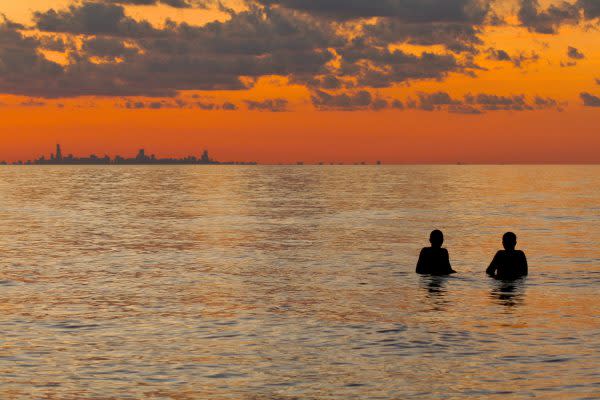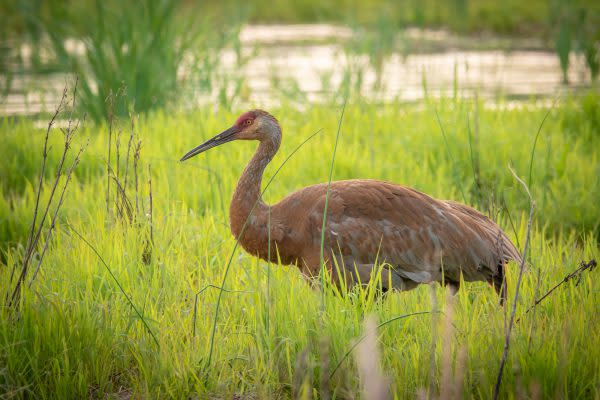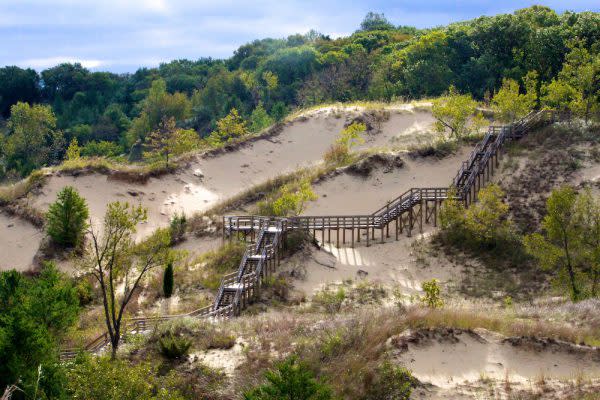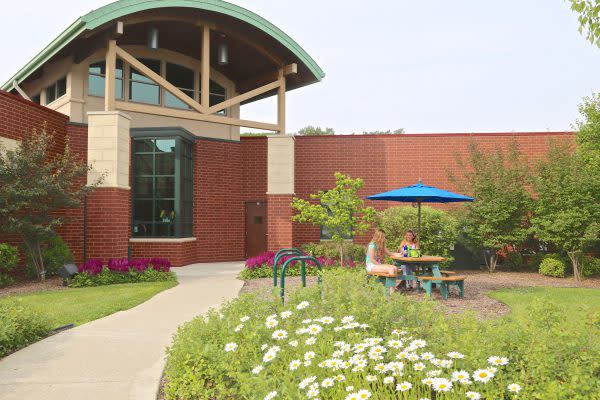Separate passes are needed for the Indiana Dunes National and State Parks. For more information, visit the Indiana Dunes Entrance Fees page.
Known by many for its beautiful Lake Michigan beaches, the Indiana Dunes area is also home to some of the world’s largest lakeshore dunes, nearly 70 miles of hiking trails, and countless indoor and outdoor vacation activities. Want to know more? Our Dunes 101 series answers the most commonly asked questions about the Indiana Dunes, including the difference between Indiana Dunes National Park and State Park.
What’s the difference between the Indiana Dunes National and State Park?
 Aerial shot of the Indiana Dunes and Lake Michigan
Aerial shot of the Indiana Dunes and Lake Michigan
In February of 2019, the Indiana Dunes National Lakeshore was redesignated as a national park. But, what's this about two different parks in the dunes?
Two park systems make up the Indiana Dunes—the Indiana Dunes National Park and State Park. Both parks have unique features that will keep you exploring for days! With so much to see and do, you’re going to want to spend more than one day at the dunes. It’s no wonder the parks have nearly as many visitors as Yellowstone each year.
The Indiana Dunes State Park spreads over 2,000 acres. You’ll find a swimming beach, nature center, and over 16 miles of hiking trails, including The 3 Dune Challenge. A historic pavilion sits on the shore and offers food and sundries. Near the beach, a large birding tower sits atop one of the dunes which is a great spot for watching the sunset.
 Indiana Dunes sunset showing the Chicago skyline
Indiana Dunes sunset showing the Chicago skyline
The Indiana Dunes National Park is located on both the east and west sides of the state park. It’s a 13,000-acre preserve stretching 15 miles along the coast of Lake Michigan. The park has hiking trails, beaches, and some pretty amazing historical sites. One of the newest trails is the Diana of the Dunes Dare. Look a little closer while in the National Park and you’ll see what makes it especially unique. It is one of the most biodiverse parks in the country with 1,960 plant and animal species living in its diverse habitats including marshes, savannas, prairies, bogs, and dunes. It's not uncommon to see Sandhill Cranes and snapping turtles or hear tree frogs singing in the trees.
 A Sandhill Crane in the Indiana Dunes National Park
A Sandhill Crane in the Indiana Dunes National Park
Wait—what exactly is a dune anyway?
 The Diana of the Dunes hiking trail at West Beach in the Indiana Dunes National Park
The Diana of the Dunes hiking trail at West Beach in the Indiana Dunes National Park
Let’s back up. So, what exactly is a dune? A dune is a big hill of sand formed by wind and water. Do you know what spawned the dunes and their diverse ecosystem? Here's a hint: it was 300 feet high and moved very slowly. Glacially slow. That's right! Over 10,000 years ago, glaciers receded north, leaving rolling hills, wetlands, Lake Michigan, and the beautiful dunes that we see here. Wind and water have carried the sand here ever since.
When we refer to the dunes, we're talking about much more than sandy hills. Sure, the beach is the main attraction, but the Indiana Dunes experience goes far beyond the beach. You can easily spend days hiking, biking, fishing, paddling, wandering, and even birding in and among the dunes. Not to mention all the nearby communities with shopping, restaurants, and hotels.
How do I get there?
 The Indiana Dunes Visitor Center
The Indiana Dunes Visitor Center
The Indiana Dunes National and State Park are located on the southern tip of Lake Michigan, just about an hour away from Chicago. You can even see the windy city's outline from the shore! But you don't get to the Indiana Dunes from just one entrance. Trails, beaches, and historical sites all have different access points.
Entering the State Park is simple. Just take State Road 49 north until you see the gate to pay your entrance fee. For the National Park, drive down Highway 12 and explore the different access points. The large brown signs along Highway 12 will show you where you need to go. If you want to be sure to mark every national park site off your checklist, stop by the Indiana Dunes Visitor Center to grab a map! The front desk staff can also help you create a personalized itinerary for your stay.
I’m convinced, so when should I visit?
Because each spot in the Indiana Dunes is unique, parking and amenities vary by location. The larger beaches, like Indiana Dunes State Park or the National Park's West Beach, have ample parking, but they can get crowded on summer weekends. Smaller beaches and locations have more modest parking. Consider visiting before 10 am during the week or after 3 pm on the weekends. On holiday weekends, the early bird not only gets the worm—it gets the parking space! Check indianadunes.com for more information about what each spot has to offer. From Memorial Day weekend to Labor Day, you can call the beach parking hotline at 219-395-1003 to hear recorded information about parking availability.
Here's another great idea for you—visit during the fall, winter, or spring for easier parking and a completely different Indiana Dunes experience. Those sandy hills make for great hiking during the fall months and unparalleled sledding in the snow.
What now?
Don't forget to check out our Dunes 101 video series on YouTube. You'll learn everything thing you need about the Indiana Dunes.
There are amazing experiences in our area just outside of the dunes. Stop by the Visitor Center located on State Road 49, just a mile before the entrance to the State Park. Inside, you can pick up an Activities Guide, chat with a park ranger, or plan the perfect itinerary with one of our excellent front desk concierges. You'll leave knowing all of the best places to eat, shop, sleep, and play.

